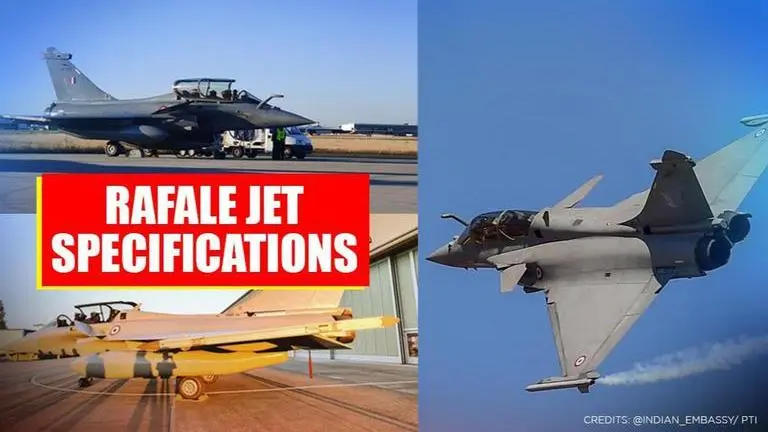Updated 27 July 2020 at 16:24 IST
Rafale Jet Specifics: From superior attack capability to menacing speed; read features
The first 5 Rafale jets is set to arrive in India on July 29. Here are some of the features which make Rafale such an invaluable addition to the IAF firepower.
- India News
- 4 min read

On Monday morning, the first 5 Rafale jets including three single-seater and two twin-seater aircraft have taken off from the Dassault Aviation Facility in France. The ferry of the jets shall be undertaken by the Indian Air Force pilots, who have undergone comprehensive training on the aircraft. Subject to weather conditions, the jets are set to arrive at the Air Force Station in Ambala on July 29, 2020.
Defence Minister Rajnath Singh had received the first Rafale during his visit to the Dassault Aviation facility in Mérignac, France on October 8, 2019. However, the arrival of the aircraft after being refitted with India-specific enhancements was postponed by two months in the wake of the COVID-19 crisis. Some of the India-specific modifications include radar warning receivers, low band jammers, 10-hour flight data recording, infra-red search and tracking systems.
Advertisement
Here are the distinct features of the Rafale fighter jets:
-
Speed
Being a Medium Multi-Role Combat Aircraft (MMRCA), the Rafale jet is known for its speed, weapon holding capacity and attack capability. The Rafale is powered by two SNECMA M88 engines, which helps it attain a high speed of 1,912 km per hour and a range of more than 3,700 km. It also has a Martin-Baker Mark 16F ‘zero-zero’ ejection seat, capable of operating at zero speed and altitude.
-
Attack ability
Having a top speed of 2223 km, it is equipped with laser-guided bombs weighing 900 kg. 2500 rounds per minute can be fired from its internal cannon. Furthermore, the presence of MICA beyond visual range missile, Hammer air-to-ground missile, Meteor, and the Scalp missiles give the IAF the ability to strike enemy targets 600 km away without having to cross the Indian air space. Additionally, the Rafale jets shall be equipped with the HAMMER missile having a range of 60-70 km. This lends India the capability to destroy bunkers, hardened shelters and other targets in all other terrains including the mountainous locations such as Eastern Ladakh.
Advertisement
-
4.5 generation aircraft
Equipped with the AESA radar, SPECTRA Electronic Warfare System and IRST system, Rafale is categorized as a 4.5 generation aircraft. This is invaluable as the IAF currently has only third and fourth generation fighter jets. At present, India has fighter jets such as Sukhoi Su-30MKI, MiG 29, Mirage-2000 and the indigenously built Tejas. However, its biggest advantage is its capability of delivering nuclear weapons.
-
Better than Sukhoi
The Rafale is fitted with 14 hard points. Its total external load capacity is more than 9 tonnes. Hence, it can lift the equivalent of its own empty weight in payloads. Its loitering capacity is 1.5 times that of the Sukhoi. The range is 780 to 1055 km as against 400-550 km of a Sukhoi jet. Similarly, the Rafale jet can engage in 5 sorties per 24 hours against 3 by the Sukhoi. Also, Rafale maintenance time per flight hour is 2.25 hours against 6-8 hrs for other fighters.
-
F-16 is no competition
While the dimensions of the Rafale and Pakistan’s Lockheed F-16 Fighting Falcon jet are similar, the latter is only a fourth-generation aircraft. Similarly, the Rafale aircraft can carry a weight of 24.5 tonnes as against 21.7 tonnes by the F-16. This implies that the Rafale can load more weapons. Also, the F-16 jets do not have the semi-stealth technology and the nuclear capability which the Rafale aircraft have. Thus, combined with the Sukhoi, the IAF will be in a comfortable position to handle the F-16s.
-
Proven ability
The Rafale has proved to be extremely vital in many conflicts over the last 13 years. The French Air Force was involved in multiple operations in Afghanistan and Libya, where the Rafale fighter jets were used. Similarly, they played a key role in Mali, helping destroy enemy infrastructure. By remaining airborne for 9 hours and 35 minutes in one such operation conducted by France, the ability of the Rafale aircraft clearly comes to the fore. Most recently, it was utilized in the peace-keeping operations in the Central African Republic.
Published By : Akhil Oka
Published On: 27 July 2020 at 16:24 IST
